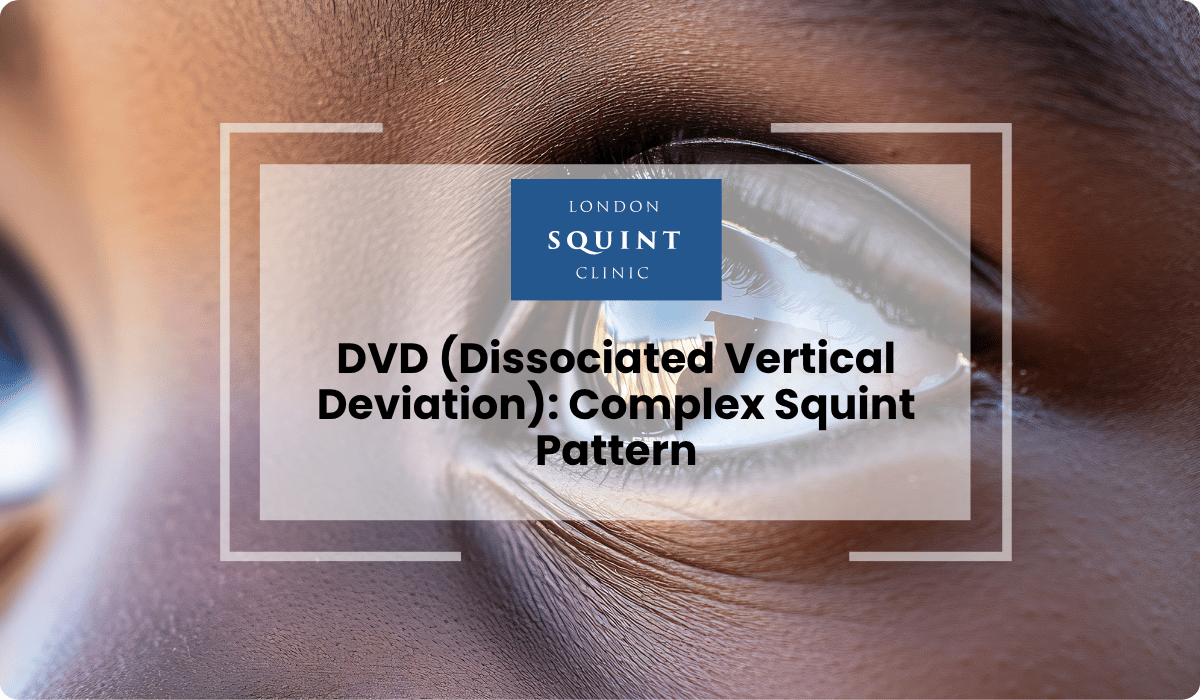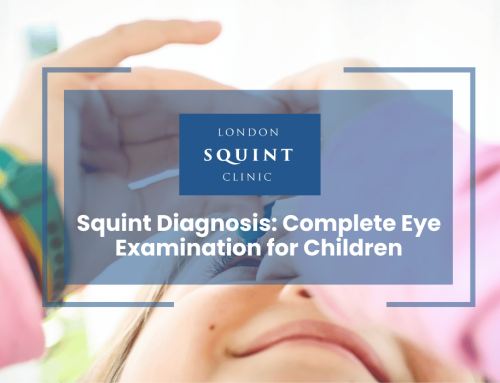DVD (Dissociated Vertical Deviation): Complex Squint Pattern
Essential Insights for Parents of Children with DVD
DVD is a unique eye condition characterized by an upward drift of one or both eyes, particularly during fatigue or reduced visual attention, and often coexists with infantile esotropia.
Light sensitivity is a distinguishing feature of DVD, with symptoms typically worsening in bright conditions—making sunglasses and hats practical daily management tools.
Treatment approaches are individualized, ranging from observation and non-surgical options like prism glasses to surgical interventions that aim for improvement rather than complete resolution.
School communication is essential—educating teachers about DVD and requesting appropriate seating arrangements can significantly improve your child’s educational experience.
Promising research developments in neuroimaging, pharmacological interventions, and advanced surgical techniques offer hope for improved DVD management in the future.
Table of Contents
- Understanding DVD: A Unique Form of Childhood Squint
- What Causes Dissociated Vertical Deviation in Children?
- Recognizing the Signs: How DVD Differs from Other Squints
- Diagnosis Methods: How Specialists Identify DVD
- Treatment Options for Children with Dissociated Vertical Deviation
- Living with DVD: Practical Advice for Parents and Caregivers
- When Surgery Becomes Necessary for DVD Management
- Future Developments in DVD Treatment and Research
Understanding DVD: A Unique Form of Childhood Squint
Dissociated Vertical Deviation (DVD) represents one of the more complex forms of childhood squint (strabismus) that ophthalmologists encounter. Unlike typical squints where an eye turns inward or outward, DVD is characterised by an upward drift of one or both eyes, particularly when the child is tired, daydreaming, or when one eye is covered. This vertical eye movement disorder often appears subtle at first but can become more noticeable over time.
DVD belongs to a group of conditions known as dissociated strabismus complex, which includes other related eye movement disorders. What makes DVD particularly distinctive is its “dissociated” nature—the movement occurs independently in each eye rather than being linked to the position of the other eye. This differs significantly from other forms of vertical squint where the misalignment follows more predictable patterns.
Children with DVD often demonstrate good visual acuity in each eye individually, but the condition can impact binocular vision (how well the eyes work together). DVD frequently coexists with other forms of squint, particularly infantile esotropia (inward-turning squint present from birth), making comprehensive assessment essential for proper management.
What Causes Dissociated Vertical Deviation in Children?
The exact cause of dissociated vertical deviation in children remains incompletely understood, but several theories have emerged from clinical research. Most ophthalmologists believe DVD represents a disruption in the normal development of binocular vision during critical periods of visual development in infancy. This developmental anomaly affects the brain’s ability to properly coordinate the movements of both eyes.
DVD rarely occurs in isolation. Approximately 70-90% of children with DVD also have or have had infantile esotropia (congenital squint), suggesting a strong association between these conditions. This connection points to shared developmental mechanisms affecting visual pathway formation in early life. Other conditions frequently associated with DVD include latent nystagmus (eye wobble that appears when one eye is covered) and inferior oblique overaction (overactivity of one of the eye muscles).
Genetic factors may play a role in some cases, as DVD occasionally runs in families. However, no specific genetic markers have been definitively identified. Unlike some other forms of squint, DVD is not typically caused by refractive errors (need for glasses), though children with DVD may also have these issues coincidentally.
The timing of visual development disruption appears crucial. DVD typically develops in children who experienced abnormal binocular vision during the first months of life, highlighting the importance of early visual experiences in proper eye alignment development.
Recognizing the Signs: How DVD Differs from Other Squints
Identifying dissociated vertical deviation requires careful observation, as its presentation can be subtle and intermittent. The hallmark sign of DVD is an upward drift of one eye, particularly noticeable when the child is tired, daydreaming, or when visual attention is reduced. Unlike other forms of squint, the upward movement in DVD often occurs when one eye is covered or when the child is looking at distant objects.
Parents might notice their child squinting one eye in bright sunlight—a compensatory mechanism as DVD often worsens in bright conditions. This light sensitivity distinguishes DVD from many other types of squint. The condition is typically bilateral (affecting both eyes), though it may appear more pronounced in one eye than the other. When both eyes are affected, they usually don’t drift upward simultaneously; instead, the non-fixing eye (the eye not actively looking at an object) shows the upward movement.
DVD differs from other vertical squints in several key ways. In DVD, the upward drift is not linked to specific directions of gaze as seen in other vertical muscle imbalances. Additionally, the magnitude of the upward drift can vary significantly from day to day and even hour to hour, making it an inconsistent finding during examinations.
Children with DVD may develop compensatory head postures, tilting or turning their head to minimise the effect of the deviation. Some children also demonstrate a characteristic “dipping” movement where the affected eye first moves downward before drifting upward—a diagnostic clue that helps distinguish DVD from other conditions. If you notice these patterns in your child’s eye movements, it’s important to seek assessment from a paediatric ophthalmologist who specialises in complex eye movement disorders in children.
Diagnosis Methods: How Specialists Identify DVD
Diagnosing dissociated vertical deviation requires specialised expertise and specific examination techniques. Paediatric ophthalmologists employ several methods to identify and quantify DVD, often during multiple visits to account for the variable nature of the condition.
The cover test forms the cornerstone of DVD diagnosis. During this examination, the specialist covers one eye while observing the movement of the other. In children with DVD, when the covering object is removed, the previously covered eye will often drift upward before returning to its normal position. This distinctive movement pattern helps differentiate DVD from other forms of vertical squint. The alternate cover test, where the cover is quickly moved between eyes, may reveal the latent component of the deviation.
Prism measurements help quantify the degree of upward drift, though these measurements often vary between examinations due to the inconsistent nature of DVD. Specialists may use special filters and lighting conditions during the examination, as DVD typically worsens in bright light and improves in darkness—a diagnostic clue that helps confirm the condition.
A comprehensive eye examination will also assess for associated conditions that frequently accompany DVD, such as infantile esotropia, latent nystagmus, and inferior oblique overaction. Detailed assessment of binocular vision function helps determine the impact of DVD on the child’s visual development.
For very young children, diagnosis may require multiple visits as DVD can be subtle in its early stages and may become more apparent as the child grows. Video recording of eye movements sometimes assists in capturing the intermittent nature of the condition, particularly when it’s not evident during the clinical examination.
Treatment Options for Children with Dissociated Vertical Deviation
Managing dissociated vertical deviation requires an individualised approach, as treatment needs vary significantly between children. The primary goal is to minimise the functional and cosmetic impact of the condition while supporting normal visual development. Several non-surgical and surgical options exist, with treatment decisions based on the severity of DVD, associated conditions, and the child’s specific needs.
For mild cases of DVD, observation may be the initial approach, particularly if the deviation is infrequent or barely noticeable. Regular monitoring ensures that any progression can be addressed promptly. When DVD is associated with refractive errors, prescription glasses may help improve overall visual function, though they typically don’t directly correct the vertical deviation itself.
Prism glasses represent a non-surgical option for some children with DVD. These special lenses incorporate prisms that bend light to compensate for the eye’s upward drift, potentially reducing the need for the child to make constant eye adjustments. However, because DVD varies in magnitude, fixed prisms may not always provide consistent correction.
Eye patching therapy (occlusion therapy) sometimes plays a role, particularly when DVD coexists with amblyopia (lazy eye). While patching primarily addresses the amblyopia rather than DVD directly, improving visual acuity in both eyes can sometimes help with overall eye coordination.
Vision therapy exercises may be recommended to strengthen binocular vision skills, though their effectiveness specifically for DVD remains limited. These exercises focus on improving eye coordination and may help with associated visual issues rather than directly treating the vertical deviation.
For children with photosensitive DVD (worsening in bright light), specially tinted glasses or sunglasses can provide symptomatic relief by reducing the triggering effect of bright light. Some children benefit from bifocal or progressive lenses that provide different corrective powers for different viewing distances, potentially reducing the frequency of DVD episodes during near work.
Living with DVD: Practical Advice for Parents and Caregivers
Raising a child with dissociated vertical deviation presents unique challenges that extend beyond medical appointments. Understanding how to support your child’s visual development while managing the practical aspects of DVD can significantly improve quality of life for the entire family.
Consistent communication with your child’s school is essential. Educate teachers about DVD, explaining that the upward eye drift may be more noticeable when your child is tired or concentrating. Request seating arrangements that minimise glare and bright light, as these can exacerbate DVD symptoms. Consider providing a written explanation of DVD for school records, particularly for physical education teachers who might misinterpret eye coordination issues during sports activities.
Managing light sensitivity often proves beneficial for children with DVD. Encourage the use of wide-brimmed hats and sunglasses during outdoor activities. At home, consider using adjustable lighting and reducing glare on screens and reading materials. Some families find that using warm-toned lighting rather than bright fluorescent lights helps reduce the frequency of noticeable DVD episodes.
Establish a consistent routine for any prescribed treatments, whether glasses, prisms, or patching. Create positive associations with treatment by incorporating it into enjoyable activities. For younger children, using sticker charts or other reward systems can improve compliance with treatment regimens.
Monitor your child for signs of social or emotional challenges related to their eye condition. Children with visible eye movement differences sometimes face questions or teasing from peers. Prepare your child with simple, age-appropriate explanations about their condition and build their confidence in responding to questions. Consider connecting with support groups where families share experiences and coping strategies for children with similar conditions.
Remember that fatigue often worsens DVD symptoms. Ensure your child gets adequate rest, particularly before visually demanding activities like exams or sports competitions. Breaking up extended periods of close work with short breaks can help reduce eye strain and minimise DVD episodes during homework or screen time.
When Surgery Becomes Necessary for DVD Management
Surgical intervention for dissociated vertical deviation is considered when the condition significantly impacts a child’s visual function or causes notable cosmetic concerns that affect psychological well-being. Unlike some other forms of squint, DVD surgery aims to reduce the frequency and magnitude of the upward drift rather than eliminate it completely, as total elimination is often challenging due to the complex nature of the condition.
The timing of surgery requires careful consideration. Most ophthalmologists prefer to wait until the DVD pattern has stabilised, typically after age 4-5 years, unless the deviation is severe and causing significant functional problems earlier. Surgery performed too early may result in undercorrection as the condition continues to evolve, potentially necessitating additional procedures later.
Several surgical approaches exist for DVD management. The most common procedure involves weakening the superior rectus muscle (the muscle responsible for upward eye movement) through recession surgery, where the muscle attachment is moved backward on the eye. For children with DVD combined with inferior oblique overaction, a combined procedure addressing both muscles may provide better outcomes.
Anterior transposition of the inferior oblique muscle represents another surgical option, particularly effective when DVD coexists with inferior oblique overaction. This procedure repositions the inferior oblique muscle to counteract the upward drift. Some surgeons prefer the Faden procedure (posterior fixation suture), which limits the action of the superior rectus muscle without completely weakening it.
Parents should understand that DVD surgery typically aims for improvement rather than complete resolution. Post-surgical expectations should include reduced frequency and magnitude of the upward drift, but some degree of DVD often persists. Success rates vary, with approximately 60-80% of children showing significant improvement after surgery, though recurrence can occur over time.
Recovery from DVD surgery generally takes 2-3 weeks, with initial redness and discomfort managed with prescribed eye drops and oral pain relief. Follow-up appointments are essential to monitor healing and assess the surgical outcome. Some children require adjustable suture techniques that allow fine-tuning of the correction in the early post-operative period.
Future Developments in DVD Treatment and Research
The field of paediatric ophthalmology continues to advance our understanding and treatment of complex eye movement disorders like dissociated vertical deviation. Current research focuses on several promising areas that may transform DVD management in the coming years, offering hope for more effective and less invasive treatment options.
Neuroimaging studies are providing unprecedented insights into the brain mechanisms underlying DVD. Functional MRI research is helping identify the specific neural pathways involved in this complex eye movement disorder, potentially leading to more targeted treatments. As our understanding of the neurological basis of DVD improves, new therapeutic approaches targeting these specific pathways may emerge.
Pharmacological interventions represent an area of active investigation. Researchers are exploring whether certain medications might temporarily modify the neuromuscular pathways involved in DVD, potentially offering non-surgical management options. While still experimental, these approaches could eventually provide alternatives for children who aren’t surgical candidates or as adjuncts to surgical correction.
Advances in surgical techniques continue to evolve. Minimally invasive approaches using smaller incisions and more precise muscle adjustments aim to improve outcomes while reducing recovery time. Computer-assisted surgical planning, which creates personalised surgical models based on each child’s specific eye movement patterns, shows promise for optimising surgical results.
Biofeedback and virtual reality therapy represent innovative approaches being investigated for DVD management. These technologies allow children to receive real-time feedback about their eye positions, potentially helping them develop greater conscious control over eye movements. Early studies suggest these methods might complement traditional treatments, particularly for older children with milder forms of DVD.
Genetic research continues to explore potential hereditary factors in DVD development. As specific genetic markers are identified, earlier intervention and possibly gene-targeted therapies might become possible in the future. This research may eventually allow for prediction of which children with infantile esotropia are likely to develop DVD, enabling preventative approaches.
While these developments show promise, parents should maintain realistic expectations about timeframes for clinical implementation. The complex nature of DVD means that advances typically undergo years of research before becoming standard practice. Continued participation in clinical research studies by affected families remains vital for advancing our understanding and treatment of this challenging condition.
Frequently Asked Questions
What is Dissociated Vertical Deviation (DVD) in children?
Dissociated Vertical Deviation is a unique form of childhood squint where one or both eyes drift upward, particularly when a child is tired, daydreaming, or when one eye is covered. Unlike typical squints, DVD is “dissociated,” meaning the movement occurs independently in each eye rather than being linked to the position of the other eye. It frequently coexists with other eye conditions, particularly infantile esotropia.
How is DVD diagnosed in children?
DVD is diagnosed through specialized examination techniques performed by pediatric ophthalmologists, including:
– Cover tests, where one eye is covered while observing the movement of the other
– Prism measurements to quantify the degree of upward drift
– Assessment under different lighting conditions (as DVD typically worsens in bright light)
– Comprehensive evaluation for associated conditions like infantile esotropia and latent nystagmus
Multiple visits may be required as DVD can be subtle and intermittent in nature.
Can DVD be cured completely?
DVD cannot typically be cured completely, but it can be effectively managed. Even with surgical intervention, some degree of DVD often persists. Treatment aims to reduce the frequency and magnitude of the upward drift rather than eliminate it entirely. Success rates for surgery range from 60-80%, with significant improvement rather than complete resolution being the realistic goal for most children.
Does my child need surgery for DVD?
Surgery for DVD is considered when the condition significantly impacts visual function or causes notable cosmetic concerns affecting psychological well-being. Non-surgical approaches are typically tried first, including observation for mild cases, prescription glasses for associated refractive errors, prism glasses, and management of light sensitivity. The decision for surgery depends on severity, impact on daily functioning, and whether the DVD pattern has stabilized, usually after age 4-5 years.
How can I help my child manage DVD at school?
To help your child manage DVD at school:
– Educate teachers about the condition and explain that eye drift may be more noticeable during fatigue
– Request seating arrangements that minimize glare and bright light
– Provide written information about DVD for school records
– Ensure your child has appropriate eyewear (sunglasses, prescribed glasses) for light sensitivity
– Schedule regular breaks during visually demanding activities
– Monitor for social challenges and prepare your child with age-appropriate explanations about their condition
Is DVD related to intelligence or developmental issues?
DVD is not related to intelligence or general developmental issues. It’s specifically a visual system disorder affecting eye movement control and binocular vision development. Children with DVD typically have normal cognitive development and can excel academically. The condition affects visual function but does not impact intellectual abilities or overall development. However, untreated visual issues can sometimes affect learning, so proper management is important.
Will my child outgrow DVD?
Children do not typically outgrow DVD. Unlike some forms of childhood squint that may resolve spontaneously, DVD tends to persist without intervention. The condition may become more noticeable as a child grows, particularly during periods of fatigue or stress. While the manifestation might change over time, DVD represents a fundamental difference in visual processing that requires ongoing management rather than something that will resolve on its own.
Find out if you are suitable for Double Vision Treatment
Not everyone is eligible for double vision surgery.
Find out if you could benefit from this life-changing surgery by taking the quick self-suitability quiz below:
Our most popular procedures

Hello, I’m Nadeem Ali
I’m one of the few eye surgeons in the world with 100% focus on Squint and Double Vision Surgery.
I have 24 years of eye surgery experience, and worked for 13 years as a Consultant at London’s renowned Moorfields Eye Hospital.
In 2023, I left the NHS to focus fully on treating patients from across the world at the London Squint Clinic. You can read more about me here.
There’s lots of information on the website about: squint surgery, double vision surgery and our pricing.
The most rewarding part of my job is hearing patients tell me how squint or double vision surgery has changed their lives. You can hear these stories here.
Mr Nadeem Ali
MA MB BChir MRCOphth FRCSEd(Ophth)





